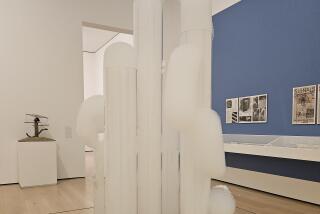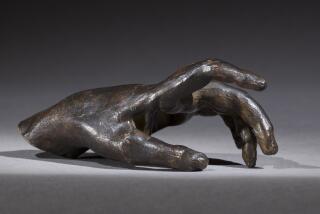Arman, 76; Sculptor Made Art Out of Everyday Objects
Arman, the French-born artist known for his sculptures made of everyday objects such as doorbells, shoes and clocks, some of which he found in trash bins, has died. He was 76.
He died Oct. 22 of cancer at his home in New York City, his wife, Corice Canton Arman, told The Times.
In a statement, French President Jacques Chirac called Arman âan untiring creator of new forms from the rejects of modernity.â Armanâs work has become âemblematic of our age,â Chirac said.
From his early years as a founder of the French art movement Nouveau Realisme, or New Realism, in the early 1960s, Arman created works that related to the art of Yves Klein, Jean Tinguely and Daniel Spoerri, other members of the group. Like them, he used real objects that he assembled in new ways to suggest that art is made from the ordinary stuff of life.
His wry sense of humor gave his creations a particular twist. In âJourney in Franceâ (1963), he encased metal sealers from wine bottles in a slab of plastic resin. âTubesâ (1966) shows empty paint tubes in resin. Many of his works were three-dimensional and designed to stand free or hang on the wall.
He moved into large-scale sculpture with such works as âLong Term Parkingâ (1982), a column of slightly crushed cars embedded in concrete. His âTime for Allâ (1985) is a construction of clock faces balanced in a precarious tower.
The discarded items he used gave his art a double edge.
âArmanâs work can be seen as tongue in cheek, or it can be seen as an artistâs comment on the excessive consumerism of our society,â said Valerie Fletcher, curator of modern art at the Hirshhorn Museum and Sculpture Garden in Washington, D.C., which owns several dozen works by Arman. âHe literally turned trash into art.â
One powerful sculpture titled âHope for Peaceâ (1995), installed near the presidential palace in Beirut, is a 106-foot column made of defunct armored tanks set in concrete.
âArmanâs art was very personal,â said Pierre Levai of the Marlborough Gallery in New York City, which represented the artist. While he was influenced by Marcel Duchamp and other Dada artists as well as American Pop and Conceptual art, Levai said, Arman did not quite fit into any one of these groups.
Born Armand Pierre Fernandez in Nice, in southern France, the artist dropped the d in his first name in the late 1950s after seeing it misspelled by a printer.
The son of an antiques dealer who painted for a hobby, Arman began painting at about age 10. He earned a bachelorâs degree in philosophy and mathematics at the Ecole des Beaux-Arts in Nice, graduating in 1946, then concentrated on art as a student at the Ecole Nationale dâArt Decoratif, graduating in 1949. It was there that he met Klein, who became a life-long friend.
Later, in Paris, Arman studied archeology and Asian art at the Ecole du Louvre for two years. He also studied Zen Buddhism and judo, which he taught for a time.
Arman served in the medical corps of the French military in Vietnam for two years in the early 1950s.
He had his first solo exhibit in Paris in 1956. Five years later, he had his first solo exhibit in the United States at the Cordier & Ekstrom Gallery in New York City. At the time, he was placing smashed cellos or violins on wood panels. He went on to work with burned objects, including musical instruments, for sculptures he called âcombustions.â
In the 1960s, he began to spend part of each year in the United States and was artist in residence at UCLA from 1967 to 1968. He became a U.S. citizen in 1973 but kept his French citizenship. He had residences in New York City and southern France.
His work is included in museum collections in France, the Netherlands and Denmark as well as the United States. Among several major exhibitions, the Jeu de Paume in Paris held an Arman retrospective in 1998.
Armanâs first marriage, to Eliane Radigue, ended in divorce. Along with his second wife, he is survived by four children and numerous grandchildren and great-grandchildren. A son, Yves, died in 1989.
More to Read
The biggest entertainment stories
Get our big stories about Hollywood, film, television, music, arts, culture and more right in your inbox as soon as they publish.
You may occasionally receive promotional content from the Los Angeles Times.










